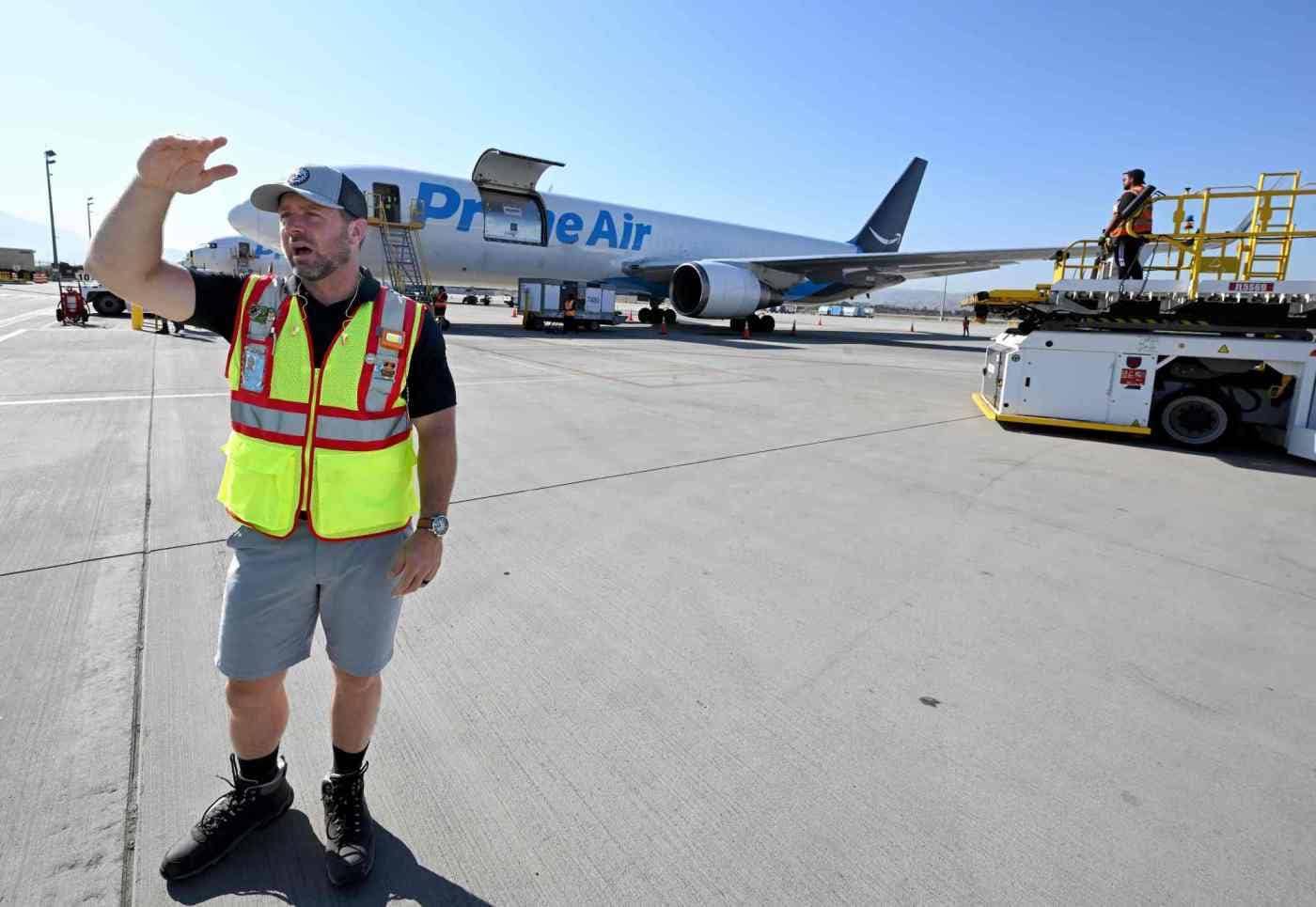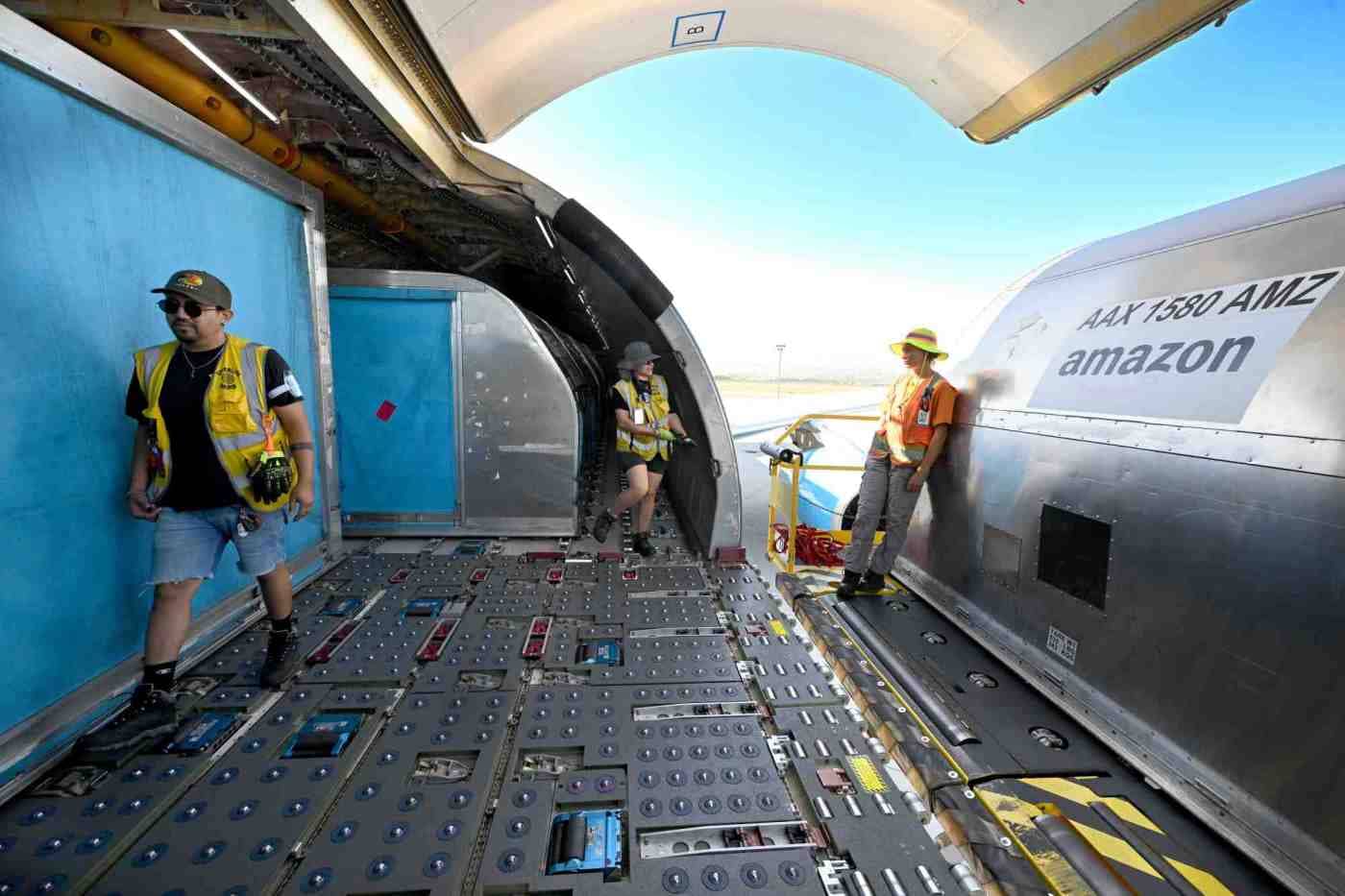R2-D2 would feel right at home in Amazon’s San Bernardino air hub.
Inside the online commerce waypoint, Roomba-like robots called drives roll up to Robins — robotic arms that snatch parcels from a conveyor belt. The drives then move single file in tightly spaced rows guided by floor-embedded barcodes.
The air hub known as KSBD — an international code for the airport housing the center — handles at least 18,000 shipments an hour in a quest to deliver consumer goods swiftly and efficiently. Robots, brightly vested humans, trucks and airplanes form a highly coordinated symphony of movement and humming machinery launched by a customer’s mouse click.
The air hub is one of eight similar facilities in the United States — and the only one of its kind in California. The third-busiest hub behind Cincinnati and Fort Worth, it links goods in fulfillment centers with customers’ mailboxes and doorsteps — the last mile.
Using aircraft “really allow(s) the network to operate with speed,” said Mike Berg, general manager for the air hub at San Bernardino International Airport. “The primary focus for us is to enable one-day delivery for our customers.”
Amazon is one of the largest employers in Riverside and San Bernardino counties, employing thousands at the air hub, delivery stations and in warehouses called fulfillment centers.
A package moves along a conveyor belt Tuesday, July 23, 2024, for sorting at Amazon’s air hub at San Bernardino International Airport. The facility handles at least 18,000 shipments an hour. (Photo by Will Lester, Inland Valley Daily Bulletin/SCNG)
During a July tour, air hub managers touted equipment and practices to keep the facility’s roughly 1,400 workers cool in a region where summertime temperatures can reach 100 degrees or higher.
The air hub, which operates 20 to 22 hours a day, is in Southern California’s Inland Empire, home to a robust logistics industry because of its blue-collar workforce, an abundance of flat, vacant land suitable for warehouses and easy freeway and rail line access to the ports of Los Angeles and Long Beach.
The facility opened in 2021 in a two-story, roughly 660,000-square-foot space at what used to be Norton Air Force Base. After closing in 1994, the refurbished base became San Bernardino International Airport and today hosts commercial, private aviation and cargo flights.
Planes, robots make for loud, busy center
Security guards at a gated entrance control access to the air hub. Visitors and employees must pass through a metal detector as they would at any other airport.
A lobby vending machine offers free earplugs, vests and other personal protective equipment. Overhead monitors and signs show information about weather conditions and tips on workplace safety and preventing heat stroke.
Sliding doors lead to the ramp, where sleek, white-colored cargo planes are loaded and unloaded amid the roar of departing and incoming flights. Ten inbound and outbound Amazon flights a day — Boeing 767s and Airbus A330s — fly out of the hub with the goal of taking off as full of packages as possible to points throughout the continental U.S. and Hawaii.
Tripod-mounted ramp sensors monitor the “WetBulb Globe Temperature,” which Berg said is a more accurate measure of heat stress. Misting fans, shade structures and coolers with ice and water offer respite from heat rising off the concrete.
Caster wheels built into a loading dock at Amazon’s San Bernardino air hub help move containers loaded into and out of aircraft at the facility at San Bernardino International Airport on Tuesday, July 23, 2024. (Photo by Will Lester, Inland Valley Daily Bulletin/SCNG)
Heat and weather conditions dictate break schedules and how often crews are rotated, said Site Safety Manager Justin Obyen, who added that workers are never more than a minute away from water. Berg said employees are encouraged to take breaks for water or rest at any point they need to.
Zero-emission equipment helps ramp workers load and unload containers known as unit load devices. The air hub also gets supplemental power from rooftop solar panels.
Unlike other planes, the newer A330s’ automation moves the containers so workers don’t have to push them into the cargo hold — a big boost for safety, Obyen said. The ramp loading dock has small wheels embedded throughout the floor to aid the movement of containers, each of which can weigh up to 4,000 pounds on average.
Air hub flights are carefully timed to ensure an efficient, orderly movement of goods to and from the planes as well as trucks on a separate loading dock. Several factors — weather, late-arriving planes or trucks and mechanical breakdowns — can throw things off.
Orders come to the air hub already packaged at fulfillment centers. After arriving, packages are “injected” into the facility through a system involving playground-like slides and a “scan tunnel” or conveyor belt with scanners that direct packages to a plane or truck.
Using robots makes life easier and safer for employees, Berg said, adding that each Robin “takes a lot of stress and strain off of our employees.”
Robots operate in fenced-off areas restricted to specially trained employees who fix broken drives and pick up packages that fall off the Amazon-made drives.
“(The drives) know when they need to charge … they go to their charge station and they begin charging,” Berg said.
Dealing with heat is cause for debate
The temperature inside the air hub stayed comfortable during the July tour. Berg said the indoor temperature never exceeds 74 degrees.
In January, the California Division of Occupational Safety and Health, also known as Cal/OSHA, cited Amazon, alleging it endangered workers in heat exceeding 100 degrees.
In June, Cal/OSHA approved rules mandating steps employers must take to keep indoor workers cool. Berg said the hub has a team dedicated to cooling and hydrating workers, who have access to cooling sleeves, towels and other heat-fighting apparel.
Workers, who picketed outside the air hub during a one-day unfair labor practices strike in July, also accuse Amazon of withholding back pay owed to employees who weren’t given required breaks. Amazon disputes the allegations.
Employees affiliated with Inland Empire Amazon Workers United, which is fighting for better wages and working conditions in Amazon facilities, take issue with the company’s messaging.
“All of these things that they’re bragging to you about are things that were fought for and won by workers,” said Sam Martin, a three-year air hub veteran. She and others describe a culture focused more on making Amazon look good than doing right by its employees.
In emailed statements, Berg said the “safety mechanisms we’ve added are a direct result of working with our employees to understand their needs and account for their suggestions. Safety is never finished; it’s a constant process and we’re dedicated to continuously improving.”
Daniel Salinas, who has worked at the hub almost three years, said Amazon “doesn’t implement the heat breaks as they should.”
“Even though there’s shade structures, we don’t always have access to them,” he said. “When we’re working (on the ramp), we’re standing under the elements the entire time unless we try to get some shade underneath one of the wings from the plane or under the belly of the plane.”
That’s not true, Berg said.
A cart, seen Tuesday, July 23, 2024, holds cooling gear that managers say is available to employees at Amazon’s air hub at San Bernardino International Airport. The online retailer says it takes a number of steps to protect workers in a region where summer temperatures can exceed 100 degrees. (Photo by Will Lester, Inland Valley Daily Bulletin/SCNG)
A “dedicated health and safety team” monitors a heat-mitigation plan and checks on employees, he said. Heat breaks “are executed daily, and monitored throughout the day,” he added.
Filling the bulk area of the planes is especially challenging, said Qwai “Q” Perkins, who will mark two years at the hub in November.
“You have to kind of bend over or get on a knee and we fill that small compartment up with these packages,” he said. “When you finish, your back is hurting from bending over.”
Perkins added: “They try to run the ship so thin, they just want the minimal amount of people to do every job so they can keep the profits at the highest level. So when it’s time for us to actually get help or we request help, there’s nobody there.”
Berg replied: “As with any logistics business, we have a shift plan. We have different levers to balance our personnel to the work demand at hand.”
The air hub has a stretching area for workers, two injury-prevention specialists and a first-aid center staffed by paramedics and EMTs. Berg said the San Bernardino air hub ranked among the top Amazon facilities to take advantage of Career Choice, a program that “essentially offers (a) free college education for associates.”
Martin is enrolled in Career Choice and takes classes at Riverside City College.
“Most people who work there live paycheck to paycheck,” she said. “I don’t think anyone feels like they’re making what they deserve and I think that Career Choice is cool … But they use it to make up for their inadequacies in other areas.”
Berg said Amazon offers “competitive pay (and) comprehensive benefits” at the hub, pay is reviewed each year and is adjusted based on factors including the cost of living.
Related links
Amazon workers strike over alleged unfair labor practices at San Bernardino air hub
California passes new workplace indoor heat rules. Again.
Amazon fined $6 million; accused of violating warehouse worker production quota law
Amazon opens its first California pharmacy in Corona
How many Inland Empire schools are next to warehouses?
San Bernardino Amazon workers say they’re owed back pay for lost breaks
These 10 communities have the most warehouses in the Inland Empire
Martin said the air hub’s culture discourages workers from seeking first aid.
“It almost puts you under the spotlight of ‘What did you mess up on that made you get injured?’”
But Berg said workers “are never reprimanded” for seeking first aid. Is someone is injured, “our managers and safety team will investigate to find the root cause and make changes, if needed,” he said.
During the tour, Amazon made Rocky Gamas, who trains co-workers on the ramp, available for an interview.
Working at Amazon is “an incredible opportunity to be able to grow and develop as a leader,” Gamas said. “We have a great phenomenal team here, incredible people. We have (an) incredible teamwork aspect going on here.”



